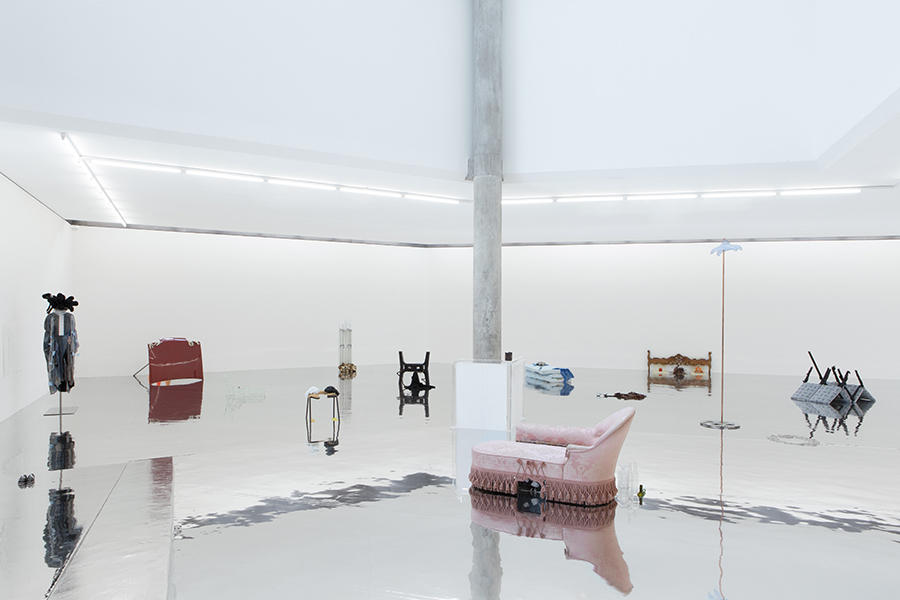From Imaginary Waffles to Patriotic Songs, Performance Artist Sophie Jung is a Master of Misdirection
In a recent performance at Kunstmuseum Basel, the artist demonstrates an impressive control of hysteria and hesitancy
In a recent performance at Kunstmuseum Basel, the artist demonstrates an impressive control of hysteria and hesitancy

Dressed in nothing but a nude body suit and a curtain fashioned into a shawl, Sophie Jung sits on a chaise longue reading excerpts from old copies of Architectural Digest. Her butler, James, played by Peter Burleigh, stands at the top of a ladder using a ladle to mimic the hands of a clock. Later, evidently bored with her magazine, Jung riffs on the lyrics of The Battle Hymn of the Republic. ‘It’s just one thing’, she says, distracted, to the audience. ‘If, if, if, sorry, if his truth is marching on though why not just stay a while? We’re in a mess. You know, maybe just for once his truth… don’t march on – help me clear up my mess.’
The lack of a cohesive narrative makes this performance – one of five staged as part of Jung’s current solo show, ‘The Bigger Sleep’, at Kunstmuseum Basel – difficult to summarize. There is a script of sorts, or at least fragments of one, but large parts of the piece are improvised. Which parts, exactly, is anyone’s guess, for Jung is the master of misdirection. One minute she’s screaming, ‘I said the heat is wet’ in a spot-on rendition of the ‘hysterical’ female archetype; the next, she slides into cognizance, telling so-bad-they’re-good puns and breaking the fourth wall to archly comment on James’s failings (‘he’s cute but incompetent’). In the performance’s best moments, I’m reminded of the German poet and Dadaist Baroness Elsa von Freytag-Loringhoven, whose nonsense verse so successfully feigned madness that she herself was often accused of insanity. And as with those most famed Dadaists, Jung’s brand of theatre doesn’t allow for the easy pleasure of immersion: onlookers must participate with their full attention or, as was the case when I was there, leave.

As is common in Jung’s recent practice, the text is based around the sculptures that comprise the exhibition itself, mostly found objects assembled into small, provisional installations: a pipe slotted through a ladder, an inflatable coat hanger perched atop a pole, beer mats pushed into the cushion creases of the aforementioned chaise longue. Some of these items are worn or used by the duo during the performance, such as the tailcoat from La Veurve (tailed) (all pieces 2018), while others become the basis for seemingly ad-libbed monologues.
In interviews, the Luxembourg-born artist has enigmatically referred to the found objects that she collects as things she ‘see[s] potential in’¹, which she then ‘write[s] [her texts] for’, and I suspect that the performances are, in part, an attempt to reveal that potential to the audience. With the props stripped of their original functions, the characters relate to them with a newfound, child-like sense of wonder and imagination. In one scene, for instance, the butler takes one of two bench press frames that Jung had arranged into the shape of a window and holds it over her head: ‘What are you doing?’ Jung asks. ‘It’s a guillotine’, he quips.

The piece is often at its funniest when the performers mime objects into being. There is something inherently absurd, for instance, about the butler giving an audience member an imaginary waffle, only to watch as a mix of politeness and amusement compels them to play along with the charade. Jung has incredible comic timing, too. When her character gets annoyed at the delay in the distribution of the battered goods, she deadpans: ‘Feed them waffle, James, not the means of making waffle’. The comment also hints at a political agenda, one seemingly backed up by other snippets of dialogue on the nature of work and labour, not to mention the dynamic between the butler and mistress. But, again: whenever you think you have grasped a narrative thread, Jung spins off on another tangent.
If I were to have one criticism of the performance, it’s that at some point it has to end, and without Jung’s compelling stage presence, the sculptural environment, which exists unto itself as an exhibition, falls flat. For me, the problem points to a wider issue pertaining to text-based performance art. As success breeds invitations from larger and larger institutions (the ‘Bigger Sleep’ is a result of Jung winning the Manor Art Award), artists whose practice is based on language are compelled to switch gears and find ways of physically filling spaces. (Think of Nora Turato’s posters, frozen transcriptions of otherwise manic performances, and the giant staircase Hanne Lippard installed in Kunst-Werke, Berlin, in 2017, to frame a minimal sound piece.) Walking through the uninspiring assembly of objects in ‘The Bigger Sleep’ on a non-performance day, I couldn’t help but think that Jung hasn’t yet found a solution. Her talent as a performer is not in doubt, but when it comes to exhibition-making, one question remains: can it work without her?
¹ ‘Studio Visit: Sophie Jung’, Elephant, 17 January 2018. https://tinyurl.com/yb7vr5fy
Sophie Jung, 'The Bigger Sleep' was on view at Kunstmuseum Basel from 1 December 2018 until 3 February 2019.
Main image: Sophie Jung, 'The Bigger Sleep', 2018, performance documentation, Kunstmuseum Basel; photograph: Julian Salinas






















